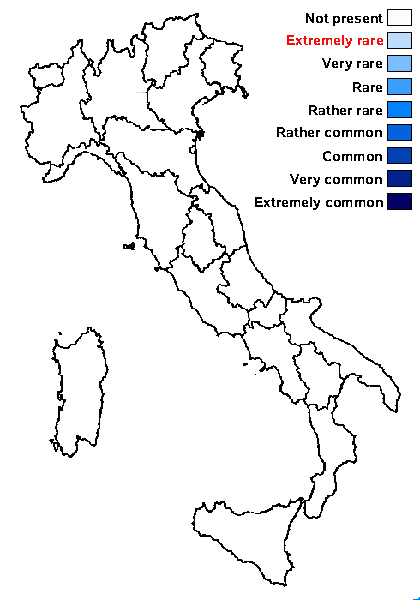Coniocybe eufuracea S. Temu & Tibell
in Temu & al., Journal of Fungi, 10, 5: 8, 2024.
Synonyms:
Distribution:
Description: Thallus subleprose, usually well-developed, thick, diffuse and poorly delimited, yellowish green, consisting of a thick mat of minute soredia-like granules. Apothecia rather frequent, stalked, pin-like, the stalk 0.6-1.5 mm tall and 0.04-0.8 mm thick, yellowish-green-pruinose at least in upper part. Capitulum globose, 0.16-0.22 mm across, with a pale brown, more or less greenish-pruinose mazaedium. Exciple very poorly developed; hypothecium pale brown. Asci 8-spored formed in chains, disintegrating early. Ascospores 1-celled, pale brown, globose, 2.3-2.6 µm wide, the wall with a minutely verrucose surface and 8-10 reticulated ornamentation ridges over the hemisphere. Photobiont chlorococcoid, with elongated cells arranged in chains (Stichococcus). Spot tests: thallus K-, C-, KC-, P-, UV+ pink. Chemistry: vulpinic and pulvinic acids, pulvinic dilactone.Note: a recently-described, cryptic species which is very similar to C. furfuracea, differing in the shorter apothecia, wider stalks, smaller
spores with an ornamentation of 8–10 ridges over the hemisphere, and especially in molecular data. The species seems to be widespread in cool-temperate to temperate areas of the Northern Hemisphere (see Temu & al. 2024), and should be looked for also in Italy.
Growth form: Leprose
Substrata: bark, lignum, rocks, soil, terricolous mosses, and plant debris
Photobiont: green algae other than Trentepohlia
Reproductive strategy: mainly sexual
In underhangs rarely wetted by rain

Predictive model
Growth form: Leprose
Substrata: bark, lignum, rocks, soil, terricolous mosses, and plant debris
Photobiont: green algae other than Trentepohlia
Reproductive strategy: mainly sexual
In underhangs rarely wetted by rain

Predictive model


